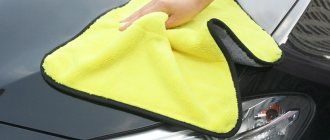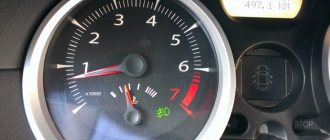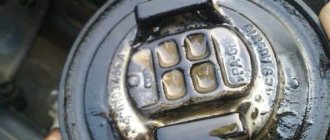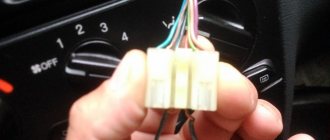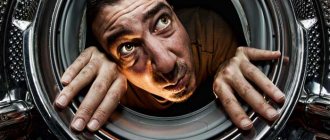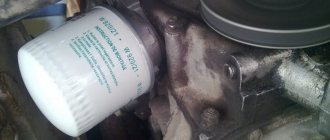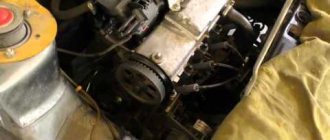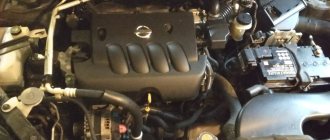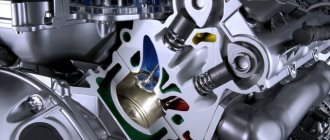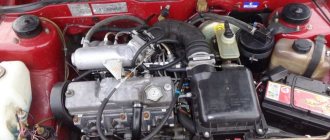Increasingly, car owners decide to undergo such a procedure as washing the engine of their favorite car. It is certainly necessary to clean the power unit, since its condition and durability depend on it. But sometimes after water procedures the engine gives drivers a surprise - the engine stalls or does not start. In order to respond to such a turn of events in a timely manner, it is necessary to understand what actions to take next.
Various problems may occur after washing your car.
Reasons for car failure to start
The reasons why the car refuses to start after washing the engine are mostly similar to faults that cause the engine to trip. The ignition system can only function normally when it is dry. Water, becoming a conductor, promotes charge flow, short circuits and other unpleasant consequences that can worsen sparking.
The starting system of the power plant is also affected by moisture. Most affected:
- Battery terminals. Their gradual oxidation is a natural process. Water that gets on the battery acts as a catalyst. The result is accelerated corrosion and loss of electrical contact. Accelerated battery discharge is also possible due to the formation of a new circuit consisting of water, salts and electrolyte;
- Generator. Entering water can damage it. In this case, after the windings dry out, operability may not return;
- Electrical wiring and other elements of the engine starting system.
Battery terminals
Pouring water into the air filter can cause the car to not start. This creates a risk of liquid getting inside the cylinders. This is fraught with water hammer. After this, an expensive overhaul of the cylinder-piston group is guaranteed.
Mazda 3 Shổtlắndkắ 新生活 › Logbook › Consequences after washing the engine
Gifter! ))) Well, it didn’t take me long to rejoice at the washed engine. I rode for 1.5 days and, as luck would have it, in the morning I go to work and drive 2 km. from strength and bam! The car begins to jerk terribly, does not pull and the “CHECK!” light comes on.
Well, I think: “that’s it, fuck it, I’m done.” I threw off the cable, waited, warned that I would be late for work, and heard a lot of new things about myself from my colleague. ))) I put the clamp on - the situation did not change, I returned home, parked the car, took off the clamp again, closed it and went to work with a relative. I’m in no mood, I’ve been browsing the Internet all day, I’ve read all sorts of things there... After work I arrived late in the evening, went straight to see what had changed, in the end nothing had changed, as soon as I drove away from the house the check light came on again, then I also noticed that the consumption had doubled
!
and the engine began to tune up. Immediately, guesses about the spark plugs or the “ignition coil” came into my head, but I stubbornly did not want to agree with this because I drove for 1.5 days after washing the engine without any hint of a malfunction. In general, I traveled for 2 working days by public transport and remembered how It’s not convenient after all))) On the same days I agreed on a computer. diagnostics for the weekend. And today we connected it to the computer. and he showed us that “the 3rd cylinder is working in emergency mode,” we went to look at the spark plugs, as soon as the protective plastic was removed, I heard a crackling sound in that same 3rd coil.
In general, when they unscrewed everything, they saw that there was a ton of water in there,
it was decided to check the remaining wells. It was a little better in the second, but there was still moisture. We blew everything out with air, dried it, screwed everything back, reset the error and the car came to life! But the on-board vehicle began to show an average consumption of 9.6, before that it was somewhere around 7.8 on the highway. One of these days I’ll install new spark plugs (I still haven’t changed them after purchasing them, I’m still choosing which ones are better) and clean the damper (in traffic jams the idle speed jumps).
The moral is this: you should wash the engine in the most extreme situations when everything is completely dirty and dirty. And if it works normally, there is no need to go there, so as not to create even more problems. We can say that I got off with a slight fright; it could have been much worse. If I need to wash under the hood, now it’s better to wipe the necessary areas with a rag.
Thank you, to those who finished reading, please like and subscribe, who haven’t done so yet)))
What to do if the car jerks after washing
When the engine stalls after washing, you need to have some kind of action plan (make a checklist) to identify the reasons. But before that, you should once again wipe the motor and wiring dry, blow all areas with air from the compressor, and clean all contacts from plaque. For hard-to-reach places, it is optimal to use compressed air rather than rags.
By the way, in some places the moisture can dry out on its own if you put the car in a dry, ventilated room. Of course, you need to check the spark plugs. This is not difficult to do, but only if you have a spark plug wrench at hand. If the spark plugs are unscrewed, it is better to clean the electrodes from carbon deposits. In addition, it is necessary to wipe the spark plug wells themselves.
Recommendations for washing the car engine
After a properly carried out washing procedure, all engines start and run without problems. Malfunctions occur only when the technology for cleaning the engine compartment is violated or when the car manufacturer’s recommendations are deviated. For example, when using a high-pressure washer, water may get under the seals and cause mechanical damage to the components. Also, for contactless cleaning, car shampoo with a more aggressive active ingredient is used. This in turn causes corrosion of aluminum and copper surfaces.
https://youtube.com/watch?v=BxmP3n4YQIQ
The most gentle way to clean the engine is to use special aerosols. Attachments that are sensitive to moisture should be covered with plastic wrap. To prevent short circuits and damage to electronics, it is recommended to disconnect the terminals from the battery. Spraying should occur on a warm engine. On a cold engine, the activity of the substances will be reduced, and a too hot power unit will lead to rapid evaporation of the cleaning agent. After applying the aerosol, you need to wait 15-20 minutes. It is necessary to rinse the engine compartment with low pressure of running water.
Upon completion of washing, it is advisable to blow out the spark plug wells. For these purposes, compressed air from a compressor is usually used. It is possible to dry using a spray can or a regular hair dryer. Upon completion of washing, it is better to leave the car in a warm garage. This is especially true when operating the machine in winter.
Washing the engine is a mandatory step to keep the engine compartment in order. When cleaning, you should strictly follow the car manufacturer's recommendations and use high-quality products. This will protect the car from unpleasant consequences in the form of a throbbing engine or difficult starting.
How to fix the situation
If, after washing the engine, it still starts to work, you need to take action. First, dry everything. Remove the high-voltage wires, individual ignition coils from the spark plugs and blow out the wells. Dry all connectors and treat with a water-repellent liquid, such as WD-40. It just has the effect of displacing moisture from the contacts. If you don't have a compressor on hand to blow it out, you'll have to wait with the hood open until it dries on its own.
How to protect from water when washing
The best remedy is, of course, not to wash the engine. But how to remove oil stains? There are several ways. The most neutral one, which does not lead to consequences, is to buy a grease remover from dishes in a store, spray it on and wait a few minutes until everything drips down. Then use a compressor to thoroughly blow through all engine parts. But no moisture or water.
The second way is to mix a little gasoline with mallow - a product that many car mechanics use to wash their hands, pour this mixture into a spray bottle, spray it on the engine and also air dry.
Elimination of uneven motor operation
Most often, the engine stalls after washing due to water getting into the ignition system. This is where you should start troubleshooting. The following items need to be checked:
- distributor, if present in the ignition system;
- armored wires;
- ignition coil;
- candle wells.
If there is liquid on any of the above elements, it must be removed. When wiping elements, you should visually check their technical condition. There may be situations when, after washing, cracked high-voltage wires or worn-out spark plugs are revealed. If you notice an element that has come out of order, you must replace it without waiting for scheduled maintenance.
It is more difficult to detect water getting inside the cylinders and damage to the sensors. Usually in this case computer diagnostics comes to the rescue. By reading the error log, a specialist can determine why the Check Engine light came on and the engine tripped.
Tips for restoring the performance of the power plant
If cleaning the engine compartment results in the engine being unable to start, the car owner should not panic and immediately call a tow truck. You can correct the situation right on the spot. It is enough to dry the places where liquid accumulates. It is recommended to adhere to the following instructions:
- Open the hood and visually inspect the power plant and other components. Any water found must be carefully removed;
- Remove the terminals from the battery and remove oxides;
- Wipe the high-voltage wires along the entire length;
- Unscrew the spark plugs and let them dry. Make sure there is no water in their planting areas;
- If there is a distributor, it must be dismantled. After this, remove the lid and wipe everything dry;
- Open the air filter housing and make sure there is no liquid in it;
- Check the status of the alarm.
If the above steps did not help, then the malfunction did not arise as a result of the engine being washed, but for other reasons. In this case, it is necessary to begin troubleshooting components and parts. For example, a cracked distributor cap could perform its functions when dry, but the appearance of moisture completely rendered it inoperable.
The main causes of tripling
There are many reasons and factors that are a catalyst for the onset of disruptions in the performance of certain components in the machine. Engine tripping is an unpleasant breakdown, but it occurs with enviable frequency on both outdated and modern models. The reason is vibration or a large amplitude of work that exceeds normal work under similar conditions and circumstances. Even if the car has 8 cylinders, the failure of just one already leads to characteristic problems.
Service station specialists or simply experienced drivers identify the following main factors that can lead to such a violation:
After washing or wiping the engine with a damp cloth, the car starts to shake because as a result of the cleaning procedure, water got into it.
Tribbing occurs due to contact of spark plugs with liquid, which do not produce the spark necessary to start the engine.
Also, problems with the car’s engine may occur due to the failure of sensors (therefore, their performance must be constantly monitored). Sensors are sensitive mechanisms that can break if car shampoo gets into them.
The equipment used in car washes (professional or private) can be the main factor that negatively affects the performance of the motor, since the washing devices operate under high water pressure. That is why it is better not to wash the engine in this way.
When the engine starts to stall after washing, the following is observed:
Increased amplitude of its work.
Constant vibration.
In difficult situations - complete failure of this element.
How to fix the problem and what the driver needs to do
Since the main cause of a malfunction in the form of tripping is water, the first thing the driver should do is try to remove it as quickly and thoroughly as possible from the surface of the engine or spark plugs. It is important to remember here that the work must be carried out in a sink. Stages:
You need to park the car in a dry place (the optimal solution is in a warm garage).
Then wipe all existing electrical wiring of the machine.
Wipe the spark plugs thoroughly (in most cases, this is the point that car enthusiasts miss).
Finally, it is necessary to check the battery terminals in order to ensure the functionality of this element.
What to do before contacting the service
An experienced driver or a novice should take into account that in some cases, a layer of dirt formed on the terminals, which has a pronounced dark color, causes the engine to start shaking after washing. It is eliminated with water, which leads to a malfunction. That is why it is important to wipe the terminals dry after cleaning and carefully tighten them.
It becomes more difficult when after washing it turns out that water or condensate particles, elements of car cosmetics or other liquid components have penetrated under the hood. In this case, it doesn’t matter at all how the washing was done: independently or by professionals, because such a nuisance can happen to anyone. In order to eliminate the consequences of moisture or condensation penetration, you will need:
Turn off the car (turn off the ignition).
Turn it on again (check operation).
In 90% of cases, after cleaning using any liquids and even shampoos, violations are present there.
If you have an ignition distributor, you will first need:
Disassemble the distributor.
Remove residual water and moisture under the lid.
Additionally, wipe the armored wires.
Check the spark plug windows to ensure they are completely dry.
If the presence of water in the spark plugs is detected, it is not recommended to start the engine with choke. Such an action will not have the desired effect (it will not stop tripping). When blowing spark plugs, it is best to remove the choke, then squeeze out the gas and only then start the engine.
Ignition works without distributor
It also happens that the car has an ignition without a distributor. In this case, to restore functionality, the car owner will need:
Unscrew the coils (all of them).
Remove them to make them easier to work with.
Blow them out.
Wipe so that the spark plug wells are dry.
It is recommended to lubricate wires with a high voltage rating with a special compound called WD-40. This will make it possible to maintain the functionality of the engine with the maximum probability after washing.
Additional recommendations
If the engine troubles significantly after washing, even after the measures taken, it is recommended to pay attention to the following:
are there any cracks or deep chips in the distributor body;
What condition are the electrical wires of the car?
The engine can also be damaged after washing only from the outside.
Timing problems
It must be taken into account that after contact with water, the timing belt may break. A quick knock of the starter will help determine the malfunction. If a break does not occur, but there is a knocking sound, then the problem may lie in problems with the ignition spark supply or with the carburetor (if the car has one). Electronic ignition should not be overlooked, since after contact with water the engine may start to troit and the car may stall while driving.
What to do if the engine misfires after washing
Increasingly, car owners decide to undergo such a procedure as washing the engine of their favorite car. It is certainly necessary to clean the power unit, since its condition and durability depend on it. But sometimes after water procedures the engine gives drivers a surprise - the engine stalls or does not start. In order to respond to such a turn of events in a timely manner, it is necessary to understand what actions to take next.
Various problems may occur after washing your car.
It’s worth understanding what the phrase “motor troubles” means. Troubleshooting is a malfunction of the engine in which one and four cylinders stop working normally. The consequence of such a malfunction may be an increased amplitude of operation of the power unit and constant vibration. At idle speed, an engine with a failed cylinder will operate unevenly, with dips.
Sometimes when driving with an engine in which only part of the cylinders are working, the car jerks noticeably. Fuel consumption also increases sharply, power is lost, and problems arise with starting the engine, especially when washing the unit in winter.
There may be several reasons why the power unit shakes after washing.
- During washing, water got into the spark plug wells. In this case, due to the presence of moisture, the spark plug cannot produce a spark, and the cylinder, as a result, fails.
- Problems with the engine can also occur due to sensors being damaged after contact with alkaline shampoo.
- Sometimes during cleaning they use equipment that delivers a stream of water under high pressure. Such methods of cleaning the motor can lead to damage to those parts that are vulnerable. For this reason, any car manufacturer defines engine washing using high-pressure apparatus as unacceptable.
Video about possible causes of the malfunction:
If we summarize the reasons for the malfunction of a power unit that has undergone cleaning, then they all boil down to the ingress of water into those parts of the engine that can function properly only in a dry state.
Finding the reasons why it triples in wet weather
After inspecting the engine compartment and making sure that there are no obviously damp places or visible damage, we try to start it. It turns out only after 5-10 attempts, while it catches 4-6 times, and even then, these attempts are not always enough to get it started. Further, after a successful first start, the car shows no signs of breakdowns, but as soon as it sits and cools down, everything repeats itself. Only 5-10 km after the start, the car starts without problems.
There is also another popular method of checking what’s what, which will help you find the real problem. Try leaving your car overnight in a place not illuminated by street lights. Then, at night, open the hood and ask someone to do the key-to-start. You yourself need to stand and watch what is happening around the “high voltage”, explosive coils, distributor. There will be “Northern Lights”. You can read on a moonless night with such a glow.
Condensation in the distributor cap
After checking the spark plugs, injectors and fuel pump, and replacing the filter to calm things down, no defects were found. Apart from these factors, you seem to have nothing else to sin about. Although in fact there is no need to dig very deep, because most likely it is condensation in the distributor cap . The cover must be carefully inspected from the inside. As an experiment, try drying it, although the distributors are different on different engines, the vulnerability in them is the same. You need to wash the inside of the distributor cover first with gasoline (to degrease), then with 96% alcohol (to remove moisture).
Many people advise buying a new distributor right away, but don’t rush to buy and change everything ahead of time. According to the never-missing law of meanness, the last of the component parts will be guilty. Only at the extreme end the distributor cap needs to be changed, and with it the slider at the same time.
Bulkhead
Reasons why the engine stalls
If the “northern lights” are discovered, which I have little doubt about, then we immediately need to start rebuilding. You need to go through everything: change the switch, distributor cap and explosive wires, then take a can of carb cleaner, the cheapest aerosol and methodically clean everything from dust, oil and all other dirt. Then we spray everything cleaned with WD or silicone spray. And now, after such manipulations, you can forever forget that the engine does not start in wet weather, troits or stalls. And regardless of whether it’s damp or dry outside, hot or cold. Although this option under consideration is the main and most common one, it is not an exception that in your case there may be some other picture.
Checking spark and coils
If the car does not start, it is also worth looking at the spark power . You should first check the spark on the central wire from the explosive coil, then one by one across the cylinders, and compare whether it is lost in the distributor or not. There may simply not be enough spark energy to ignite the mixture. But it’s not enough because either the gap in the spark plugs is large or there is moisture on the wires. Moisture on high-voltage wires increases the capacitance of the wires, and consequently the current leakage.
The main reasons for unstable engine operation after washing
As a rule, if problems arise with the engine after washing, car owners complain that the power unit is not working. That is, not all cylinders are working. The following signs and symptoms may also be observed: loss of power, increased fuel consumption, problems with starting the internal combustion engine, etc.
Note that there are not so many main reasons why the engine jerks after washing:
- damp candles. Water enters the spark plug well, as a result of which a spark does not occur at the spark plug electrodes.
- It also happens that there is a spark, but it is not powerful enough. If the spark plugs work in this state for a long enough time, they may well completely fail;
- damage to sensors by detergents (if they contain alkali);
- damage to elements in the engine compartment due to excess water pressure during washing;
As you can see, if the car jerks after washing the engine, all problems arise due to errors during the process of removing contaminants, as well as as a result of neglecting basic rules and recommendations.
Most often, drivers strive to wash their car and engine cheaply and with the least amount of effort. To do this, many people prefer to use equipment that creates a high-pressure water jet to wash the engine.
For example, regular car shampoo and Karcher engine wash. The result is moisture ingress, unstable operation of the internal combustion engine or the inability to start it. In the worst case, a short circuit may occur.
Nuances and important points: why wash
If there are problems, then after washing (professional or self-washing) there will be a deterioration in performance - the car’s engine will begin to stall. As a result:
The car will stop starting.
It will stall on the road.
It will stall after factory.
It won't start the first time.
The problem needs to be fixed as quickly as possible so that there is no need to overhaul the engine or replace it.
Possible reasons
Why does the engine stall? Why does the carburetor shoot? Uneven engine operation can be observed as a result of the following common malfunctions:
- the most common reason is failure;
- incorrect ignition timing adjustment;
- breakdown of high-voltage wires;
- air filter clogged;
- use of spark plugs for purposes other than their intended purpose;
- carburetor not adjusted;
- capacitor failure;
- burnout of pistons and valves;
- wear, breakage, deformation of piston rings;
- violation of operating valve timing;
- high wear on valve rockers;
- air leakage through the vacuum brake booster or intake manifold;
- leaky membrane of the vacuum ignition timing regulator;
- wear of the distributor shaft or rotary plate bearing;
- destruction, breakdown, hardening, wear of valve stem seals;
- breakdown or burnout of the cylinder head gasket.
It is necessary to begin repairs when a non-functioning cylinder is identified. Finding it is not particularly difficult. With the engine running, the tips of the high-voltage wires are removed from the spark plugs one by one. On the working cylinder, after removal, the sound becomes different. If, after removing the tip, the sound remains the same, this cylinder does not work.
Similar articles:
- After washing the engine, the car does not start: possible causes and solutions to the problem
- Car starter malfunction. The most common causes of a poorly functioning starter
- Why does the engine eat oil - causes and consequences
- Why does the car jerk while driving?
see also
Air leak
- 193 9 266k
Troubles a cold engine. A selection of discussions
- 9 0 34k
Knock sensor: device, functions and purpose
- 59 0 55k
Why does the engine stall?
- 10 1 38k
Signs of valve burnout
- 45 5 110k
The question “why does it start in wet weather” is especially relevant with the advent of rainy weather, when it is constantly excessively humid and damp, and quite a lot of car owners are faced with the problem when their car does not start in wet weather . It is especially problematic to start a car after being idle overnight.
As a rule, in the mornings, during a rush, a most unpleasant situation appears: it doesn’t want to start, then it stalls, or even just stalls in damp weather. There is, of course, only one reason – moisture. But where exactly did it get and where did it leak? A visual inspection of the engine compartment is unlikely to reveal any obvious damp spots or defects.
How to quickly find the cause of the problem
In some cases, it is extremely simple to determine the nature of the malfunction, and the same applies to its elimination. The fact is that the car has many warning lamps on the instrument panel. For example, the low oil pressure light came on and at the same time the check light came on. Whether you have an Opel or a Nissan, there is not much difference. Here it is clear that the problem is the lack of pressure in the lubrication system.
The same applies to the cooling system. It has a rather complex structure and is responsible for effective heat removal from the engine. Elements such as a pump are responsible for circulation, and the filler cap maintains a certain pressure in the system. If something goes wrong, the engine heats up and the coolant temperature needle creeps up. When boiling, the “check” will light up. Here, too, it is clear that the problem is in the cooling system, so you need to start with it.
Why does the car jerk at low speeds?
Power system malfunction
Most often, a faulty operation of the power system is the cause of the car jerking when the engine is running at low speeds. The problem is related to the fact that the air-fuel mixture enters the cylinders in the wrong proportions. Accordingly, ignition of such a mixture may occur at the wrong moment, which is why the car will jerk when driving at low speeds or accelerating. It is recommended to check the following elements of the power system:
- Sensors Test the idle speed, mass air flow and throttle sensors;
- Fuel injection nozzles. It is recommended to carry out diagnostics and, if necessary, clean the engine injectors;
- Air ducts for the tightness of the connection between the receiver and the air filter;
- Fuel line connected to the pump. It is possible that there are pressure losses in it;
- Throttle assembly.
If your car has a carburetor engine, you need to check the fuel pump, the carburetor itself, and the idle air valve.
Problems in the ignition system
If there are serious problems in the ignition system, it is unlikely that the engine will be able to start. However, even if the engine starts without problems, it is likely that it jerks at idle precisely because of problems in the ignition system. Most often, the culprit is untimely ignition of the air-fuel mixture or low voltage. You need to look for the problem of the car jerking at low speeds in the following components of the power system:
Sensors Check crankshaft and camshaft position sensors
Please note: If the crankshaft position sensor fails completely, the engine will not start; Candles. Make sure spark plugs do not need to be replaced
By diagnosing spark plugs by soot on them, you can find out about various engine malfunctions. You should also check the spark plug gap to ensure it meets the engine manufacturer's recommendations;
High-voltage wires need to be checked visually and with a multimeter;
The ignition coil should be diagnosed for breaks in the primary and secondary windings, as well as for the presence of external damage.
In rare cases, the problem may be related to the knock sensor, but more often if it fails, the car engine simply will not start.
Gearbox malfunction
It is possible that the problem is related to the automatic transmission. If the machine jerks, it is necessary to carry out a full diagnosis. Most often, problems with automatic transmissions arise after a mileage of 100,000 kilometers, but for each car this figure is individual, and it depends on the operation of the car.
Bad fuel
If the car starts to jerk at low or high speeds after refueling at an unknown gas station, there is a high risk that gasoline that is not intended for it is entering the engine. Simply put, the fuel tank was filled with gasoline with an octane number that differs from the usual value for this engine. In such a situation, it is recommended to drain the bad fuel and refill with new gasoline of proper quality.
How to identify a malfunction
The breakdown can be visually determined by the following behavior of the car: if the idle speed is started (not aimed at making the car move), the faulty engine will not operate as intended by the manufacturer. Also, his work may be accompanied by failures.
An additional element by which the malfunction is determined: the car starts, but begins to stall. The more severe the malfunction, the more often such engine stops occur. Even after the factory, the car may begin to twitch noticeably. It is also recommended to pay attention to the presence of the following “symptoms”:
Fuel consumption increases sharply (up to 2-3 times in total for a certain period of road) (gasoline or diesel does not matter in this case). For example: 50 liters was enough to travel 500 km, but after a malfunction occurs, the same amount will only be enough for 300 km.
The usual power is noticeably lost - the declared horsepower is no longer enough for the car to perform usual actions (for example, it becomes more difficult to overcome poorly cleared roads in winter).
There are problems starting the engine.
In 90% of cases, problems after washing are observed in the cold season or in regions where the climate is unstable. In most cases, frozen water leads to the formation of ice, which also negatively affects overall performance.
Troit in wet weather
The question very often arises: “Why does the engine stall in wet weather, that is, in high humidity?” Quite often, drivers have problems starting the engine in wet weather, and after an overnight stay, the car does not want to obey at all.
Especially in the morning, when everyone is rushing to work, a problem arises with the fact that the car either stalls or does not even show symptoms of operation, and everything lies in only one thing - excessive humidity. But how can you determine where moisture is very high and how it got there? If you just look under the hood, you are unlikely to find answers to your questions, so it will be very difficult to clearly notice damp spots.
How to figure out what is causing problems in wet weather?
If you have carried out a visual inspection of the car under the hood and did not see any wet places, as well as any indicators of damage, the first thing you should do is start the engine.
We achieve success only on the 5th, or even 10th attempt, the grip occurs only 4-5 times, in most cases, even 10 attempts are not enough to successfully start.
If you still start on the first try and do not observe any obvious problems, then you should let the car cool down, after which the problem will repeat. Only after a run of 10 km will the engine start up without causing any problems.
You can check in other simple ways to find the problem. To do this, you should park the car in an unlit place. After this, at night you should open the hood, after which your partner should turn the key to the start. And at this time you observe what processes are happening near high-voltage circuits. You will notice a seamless “northern lights”.
Condensation formed in the distributor cap.
After checking the injectors and fuel pump, it is best to change the filters; if no problems are found, then there are unlikely to be other problems. It’s not worth going too deep; in this case, you can only blame the condensation that has formed in the distributor cover.
Let's move on to inspecting the cover, studying it from the inside. Of course, you can even dry it, but the distributors are installed differently on different engines, but the vulnerability in them is the same. Therefore, it is worth washing the lid from the inside first with gasoline or degreaser. Then remove the moisture with alcohol.
Why does the engine still stall?
If the “northern lights” are detected, and this happens extremely rarely, it is best to overhaul the engine.
Many of its parts are subject to reassembly: the distributor cover and high-voltage wires, after which, armed with a can of cleaner, the cheapest copy will do to treat everything from accumulated dust and dirt.
Next we treat everything with VDeshka, you can also use silicone spray. Now this problem will no longer bother you during wet weather, and engine stalling will also stop. Now any weather conditions will not affect engine operation. This scenario is the most popular, but you can also encounter other problems.
If you have problems starting the engine, you need to monitor the power of the spark. To do this, we observe the spark located on the central wire from the high-voltage coil. Next, we move on to the cylinders, after which we observe its power in the distributor, whether it remains there or disappears. After all, the reason may be a simple lack of spark that ignites the mixture. And this happens as a result of the formation of a large gap between the spark plugs, or as a result of the formation of moisture. If moisture is observed on high-voltage wires, then the capacitance has increased and current leakage occurs.
What can you say if the engine in a Logan is misfiring?
Do not forget that it is necessary to check the coils themselves, because if cracks form on them, then moisture enters through them from the external environment. It is necessary to check both their operation and appearance, because any manifestation of soot that appears from the spark plugs during slow driving.
When the engine cools down, it sucks in air from the outside, and the carbon deposits formed on the spark plugs are moistened.
Therefore, it is in wet weather that your engine will start to stall.
Therefore, in this case, we perform the following manipulation: before turning off the engine, press the gas pedal and reach 4000 rpm, after which we turn off the ignition. After this, the engine will make sounds reminiscent of smacking, it will get rid of accumulated carbon deposits and stall. And in the morning you should not encounter this problem, but keep in mind that this concerns the problem with candles. It would be advisable to simply replace the spark plugs with new ones, because they are still reasonably priced.
Conclusion
Summarizing all that has been said, it is worth drawing your attention to the fact that you should not exclude the possibility of moisture influencing wiring that is not related to the ignition; these can be various contacts and connectors. After all, they can also have an impact on engine performance. Therefore, after all the actions, be sure to pay attention to the contacts, after which you can rest assured that your engine will no longer stall either in damp or hot weather.
Is it necessary to wash the engine?
There are many opinions and rumors regarding this issue. There are always pros and cons, pros and cons. One of the reasons why the engine is washed is heavy leaks of oil, antifreeze, or antifreeze. The biggest cause of this, of course, is the oil sludge on the engine. It interferes with normal cooling in the summer and the engine overheats. To see and then eliminate where the oil is leaking from, it’s a good idea to wash the engine in a car wash with special chemicals and knock it all down under pressure with water. Coolant corrodes contacts, engine harness wires, electronic control unit and other electrical components of the internal combustion engine, which can adversely affect the operation of the engine.
If the car is often driven outside the city, in the forest, or on rough terrain, dirt sticks heavily to the engine, cooling fan, and radiator. If you don’t knock the clay off the fan in time, it will create vibration and simply break the bearing over time, and you’ll have to replace it. And the cost reaches, especially on foreign cars, colossal amounts.
This way, you can be sure that engine washing is necessary in some cases. But doing it just for the sake of prevention, or against dust, makes no sense. After all, the price of such a procedure can result in tens, or even 100 thousand rubles. One of the expensive components in the engine compartment is the electronic engine control unit. Its cost is measured in tens of thousands of rubles, it all depends on the make of the car. The second most expensive part and the most risk of failure is the ignition coil. It's not cheap. Why are these expensive parts listed in the engine compartment? The thing is that when washing the engine, the car starts to misfire, precisely because of them.
No spark
Since a high-pressure apparatus is used when washing the engine, the amount of water it produces is enormous. Some of it ends up in spark plug wells on sixteen valve, two shaft or more engines. Car owners, of course, do not suspect this; they start the engine, the coil begins to spark through the water onto the engine ground and immediately closes. If in such a situation you do not turn off the engine and drive further under load, the coil can pierce the primary circuit so much that reverse current flows towards the electronic control unit and burns through the transistor that controls the coil and nearby circuit board tracks. Then the brain cannot be restored; you will have to buy a new one. It's not a cheap purchase and most cars don't have them in stock.
Often, when selling a car, the engine is washed in order to hide oil leaks, or simply for beauty in order to sell it at a higher price. For example, on vases with an eight-valve engine, the ignition coil, which is located opposite the cooling radiator, is immediately filled. It strikes a spark and covers high-voltage wires and spark plugs along the chain. It is rare, but there is a breakdown of the ECU itself, as described above.
Thus, when water gets into the spark plug wells after washing, the engine shakes and the car jerks violently. Until the water is removed from there and the broken parts of the high-voltage circuit are replaced, the motor will operate unstably. After washing the engine, you can leave the car with the hood open for a while and wait until all the parts dry. The best option, of course, would be to blow the engine with air from the compressor.
Action of alkali
Shampoos for washing cars and engines have a powerful alkaline composition that is designed for oil and fat deposits. He washes them off in one go. But when they wash the engine with it, contact also occurs with the plastic of sensors, high-voltage wires, and ignition coils. The composition of the product begins to corrode, especially on older cars, the wiring and short circuits appear, which leads to tripping, and worst of all, when the car does not start.
Why does the engine stall in wet weather?
Many car owners complain that the engine stalls in wet weather. As a rule, the problem is most pronounced after a long period of inactivity, for example, after parking overnight. It is possible to start the engine at best on the fifth or sixth attempt; it runs unevenly until it warms up completely. A superficial visual inspection does not give any results. The operation of the power unit finally returns to normal after several kilometers of travel and after that the engine runs without problems for some time (either until it cools down completely, or until the next time it gets into wet weather).
Don't forget about the spark plugs. If the engine starts reluctantly in wet weather, it may be time to replace them, or they produce too weak a spark, which is not capable of igniting the working mixture in the cylinders. The spark must be checked correctly; to do this, the spark plug must be placed one and a half to two centimeters from the ground, and then turn on the starter. The spark should be bright blue. A weak spark indicates a weak current, the cause of which may lie in high-voltage wires, or a large gap between the electrodes.
The fact is that in damp weather moisture settles on them, which leads to current leaks. In addition to wires, ignition coils may be to blame for current leakage. Often cracks appear on their body, into which water gets in.
To prevent the engine from stalling in wet weather in the future, many car owners clean the distributor cover, high-voltage wires and ignition coils from dirt and oil using a Carb Cleaner aerosol can, and then coat the cleaned space with silicone lubricant or WD-40 liquid. After these simple manipulations, the problem, as a rule, does not return (the same measures can be taken after washing the engine). » alt=»»>
Tags
cause of malfunctions afterOther malfunctions review of engine malfunctionsvarious malfunctions of such malfunctions canOther malfunctions of such malfunctions occuridentify the malfunction identify the malfunction with the malfunction will be shampoo sensors came outdamage to sensors with washable sensors.on sensors.shampoo sensors came out similar sensors.failure of sensor.damage to sensors.damage to sensors by washing ECM sensors
gas injector indicatorexhaust steam control position
What and how to wash the engine as safely as possible
If you need to clean the engine yourself, you should follow certain rules.
Please note that you will be working with auto chemicals, which requires increased care and extra precautions (gloves will be needed, and there may be an additional need for eye and respiratory protection). The next step is the need to determine the nature of the contamination of the internal combustion engine. Those contaminants caused by car oil that is caked and covered with a layer of dust cannot be washed off quickly.
It is necessary to apply detergents for the time specified in the accompanying instructions to soften contaminants of this nature.
It is better to immediately abandon the decision to wash the engine under high pressure water with a Karcher if there is the slightest doubt about the advisability of this method. It is quite possible to successfully apply and wash off the applied solution with a brush or a stream of water under normal pressure, but this will require additional time.

